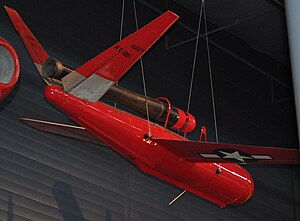McDonnell TD2D Katydid
| TD2D Katydid | |
|---|---|

| |
| McDonnell KDD-1 on display at the Steven F. Udvar-Hazy Center | |
| Role | Target drone |
| National origin | United States |
| Manufacturer | McDonnell Aircraft
|
| First flight | 1942 |
| Primary user | United States Navy |
The McDonnell TD2D Katydid was a
McDonnell Aircraft that entered service with the United States Navy
in 1942, and continued in use until the late 1940s.
History
In March 1941,
Operational history
The Katydid entered service in 1942;Douglas Aircraft - to "H", the KDD-1 being again redesignated, as KDH-1.[7]
Surviving aircraft
A KDH-1 is displayed in the Steven F. Udvar-Hazy Center of the National Air and Space Museum, having been donated by the U.S. Navy in 1966.[2]
Specifications (KDD-1)
Data from Udvar-Hazy Center,[2] Parsch 2003[7]
General characteristics
- Crew: None
- Length: 11 ft 2 in (3.40 m)
- Wingspan: 12 ft (3.7 m)
- Gross weight: 320 lb (145 kg)
- Powerplant: 1 × McDonnell XPJ40-MD-2 pulsejet, 60 lbf (0.27 kN) thrust
Performance
- Maximum speed: 250 mph (400 km/h, 220 kn)
- Endurance: 40 minutes
See also
Aircraft of comparable role, configuration, and era
- Curtiss KD2C Skeet
- Globe KD2G Firefly
- NAMU KDN Gorgon
Related lists
References
Wikimedia Commons has media related to McDonnell TD2D Katydid.
- ISBN 978-1557500892.
- ^ a b c d "Katydid Drone". National Air and Space Museum. Smithsonian Institution. 27 September 2016. Archived from the original on 2017-12-03. Retrieved 2017-12-06.
- ASIN B000MAEGVC.
- ASIN B000HKMGMI.
- ISBN 978-0760321157.
- ^ "Navy Guided Missiles". Astro-Jet (18). Reaction Research Society: 12. Fall 1947. Retrieved 2017-12-06.
- ^ a b Parsch, Andreas (26 March 2003). "McDonnell TD2D/KDD/KDH Katydid". Directory of U.S. Military Rockets and Missiles, Appendix 1: Early Missiles and Drones. Designation-Systems. Retrieved 2017-12-03.
